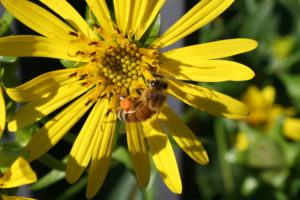
What About the Effect of Fungicides on Bees?
Question: We hear so much about the supposed negative effects of the neonicotinoid systemic insecticides on bees; however, what about the effects of other pesticides such as fungicides?
Answer: You ask a very good question. The main focus of the effects of pesticides on bees, in particular the honey bee, Apis mellifera (Figure 1) and other pollinators, has been associated with the neonicotinoid systemic insecticides. However, although fungicides are generally considered to be relatively safe to bees, scientific evidence has shown that some fungicides can be harmful to bee populations. In fact, honey bees are more likely to encounter fungicides than insecticides in agricultural settings when foraging for pollen and nectar because fungicides are sprayed on crops in flower that are attractive to bees. In addition, honey bee pollen stores and wax combs may be inadvertently contaminated with fungicides.

The overall effect of pesticides on bees is a very complex topic, so, for the sake of brevity I will highlight the key information regarding the effect of fungicides on bees.
First of all, pesticide (insecticides, miticides and fungicides) exposure can lead to direct or indirect effects. Direct exposure to wet sprays or dried residues on leaves or flowers (Figure 2) can kill adult bees. Indirect exposure is associated with sublethal effects on foraging behavior, development, orientation, reproduction, learning and memory retention, and social interactions resulting from sharing a contaminated food source.
For example, the sublethal effects of some fungicides can negatively affect honey bees in a way that resembles nutrition deficiencies or weakens honey bees by compromising the immune system, thus increasing susceptibility to parasites (e.g., Varroa mite, Varroa destructor) and/or pathogens (e.g. Nosema cerane). In addition, exposure to the fungicide, myclobutanil (Eagle), has been shown to have sublethal effects by reducing the respiration rate of bee workers. Therefore, the sublethal effects of fungicides not only can impact individuals but can also lead to colony losses.

Another important factor is related to the common practice of tank mixing pesticides. For instance, mixing insecticides with certain fungicides can synergize the acute (short-term) toxicity of the insecticides to honey bees. Synergism is a reaction that occurs when one pesticide in a mixture enhances the toxicity of the other pesticide, thereby increasing toxicity of the pesticide mixture to bees. The activity of some pyrethroid insecticides, for example, is enhanced by certain fungicides, especially those classified as ergosterol biosynthesis inhibitors (EBIs), which consequently increase bee toxicity. In addition, the fungicide propiconazole (Banner Maxx II) increases the toxicity of the pyrethroid insecticide, lambda-cyhalothrin (Scimitar), to bees when the two are mixed
together. However, the synergistic enhancement of pyrethroid toxicity by certain fungicides is dependent on the proportion of the fungicide in relation to the insecticide in the mixture. The higher the proportion of the fungicide compared to the insecticide, the greater the synergistic enhancement.
Furthermore, studies have reported that mixing some neonicotinoid systemic insecticides with certain fungicides can increase bee toxicity by as much as a thousandfold. However, it is important to differentiate between laboratory and field studies as synergistic enhancement affiliated with honey bee toxicity under laboratory conditions may not predict synergistic enhancement under field conditions.


 Video Library
Video Library 




















